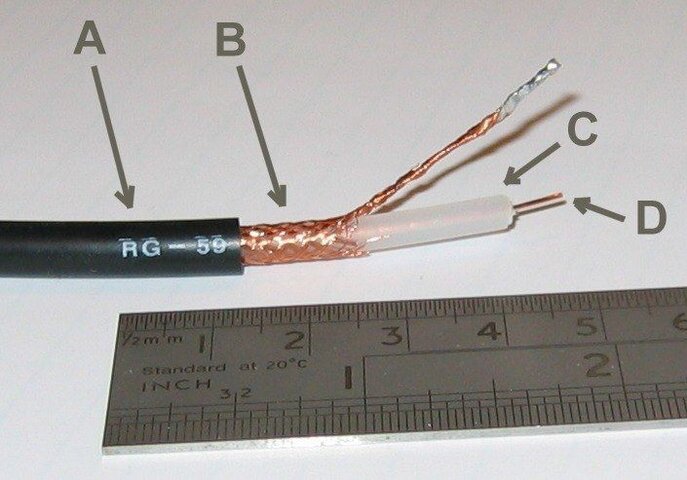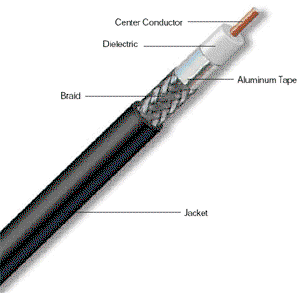Coax Cable Resistance
Quality coax cable is critical for weaker sat signal reception. Below is given excerpt from Coaxial Cable - An Overview (click Tech Info - Coaxial Cable) - the article written in simple terms by an experienced Sat Installer. This article section compares RG59 to RG6 cable, and offers his method to calculate max cable length still allowing to control switching sat components.
"That brings us to the point of comparing RG6 vs. RG59
In the old houses we still can meet homeruns made by RG59 cables.
RG59 is a lower grade of coaxial cable than RG6, consisting of a smaller center conductor, a smaller insulating dielectric, and a single outer shield. However, it delivers acceptable performance for CATV. RG-59 has a 22 AWG center conductor.
RG6, on the other hand, has a larger center conductor (18 AWG), a dual or quad shield (2 braids and 2 foils), and a much larger insulating dielectric.
The benefits of using RG6 cable include: more bandwidth, lower susceptibility to interference, and lower attenuation per foot. All of these characteristics allow it to handle a higher bandwidth than RG59 cable. RG6 delivers exceptional performance for CATV, satellite, and all other video applications and is considered the cable of choice for digital TV.
Length of cable
RG59 has electrical 'voltage drop per foot' to a direct current 0.06 V.
RG6 has electrical 'voltage drop per foot' to a direct current 0.04 V. (see the characteristics of the cables)
Voltage drop depends on resistance of the cable. Encyclopedia of Physics states that resistanceof a long cylinder or wire is given by:
R=?× L/A,
where L is a length; A is a cross section area or diameter; ? – resistivity of the material.( Ohm/meter)
That is determines maximum length of cable between LNB and receiver (power source in that case) 125 feet.
125 feet × 0.04V/foot = 5 volts. (difference between 13V and 18V)
Technically since everything has a tolerance so that LNB seems to switch to the Left hand polarization even with lower voltage."
Question:
One question seems obvious from the above calculation is that if one's coax cable length exceeds 100 - 125 ft, he would need to use a powered switch to supply stabilized power to the LNBs independently of the receiver. The switch itself would need to be located no further than 100 ft from both the receiver and each LNB. Is that calculation correct?
Anyone has experience in running longer than 125 ft cables and having no problems with LBN polarity control? What kind of cable worked best for you?
Quality coax cable is critical for weaker sat signal reception. Below is given excerpt from Coaxial Cable - An Overview (click Tech Info - Coaxial Cable) - the article written in simple terms by an experienced Sat Installer. This article section compares RG59 to RG6 cable, and offers his method to calculate max cable length still allowing to control switching sat components.
"That brings us to the point of comparing RG6 vs. RG59
In the old houses we still can meet homeruns made by RG59 cables.
RG59 is a lower grade of coaxial cable than RG6, consisting of a smaller center conductor, a smaller insulating dielectric, and a single outer shield. However, it delivers acceptable performance for CATV. RG-59 has a 22 AWG center conductor.
RG6, on the other hand, has a larger center conductor (18 AWG), a dual or quad shield (2 braids and 2 foils), and a much larger insulating dielectric.
The benefits of using RG6 cable include: more bandwidth, lower susceptibility to interference, and lower attenuation per foot. All of these characteristics allow it to handle a higher bandwidth than RG59 cable. RG6 delivers exceptional performance for CATV, satellite, and all other video applications and is considered the cable of choice for digital TV.
Length of cable
RG59 has electrical 'voltage drop per foot' to a direct current 0.06 V.
RG6 has electrical 'voltage drop per foot' to a direct current 0.04 V. (see the characteristics of the cables)
Voltage drop depends on resistance of the cable. Encyclopedia of Physics states that resistanceof a long cylinder or wire is given by:
R=?× L/A,
where L is a length; A is a cross section area or diameter; ? – resistivity of the material.( Ohm/meter)
That is determines maximum length of cable between LNB and receiver (power source in that case) 125 feet.
125 feet × 0.04V/foot = 5 volts. (difference between 13V and 18V)
Technically since everything has a tolerance so that LNB seems to switch to the Left hand polarization even with lower voltage."
Question:
One question seems obvious from the above calculation is that if one's coax cable length exceeds 100 - 125 ft, he would need to use a powered switch to supply stabilized power to the LNBs independently of the receiver. The switch itself would need to be located no further than 100 ft from both the receiver and each LNB. Is that calculation correct?
Anyone has experience in running longer than 125 ft cables and having no problems with LBN polarity control? What kind of cable worked best for you?
Attachments
Last edited:



